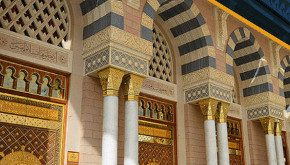Every aspect of the religion of Islam relating to women revolves around modesty and shame. It is in this regard that Islam commands women to remain within the confines of their homes, being totally concealed from the gazes of strange men and not to leave their homes without a valid Shar’ee need. The manner in which a woman is commanded to perform her Salaah — commencing from her attire for salaah to her postures during Salaah — all clearly point towards the aspect of concealment. Hence, let alone the various other ibaadaat of Deen, the Salaah of a woman alone illustrates the great degree of modesty and shame a woman is required to display. Hence she is commanded to adopt the very same degree of modesty and shame in other departments of her Deeni and worldly life which she displays in her Salaah.
Contents
The four Mazhabs
From the era of Rasulullah (Sallallahu Alayhi Wasallam), Sahaaba, Tabi’een and the centuries that followed, women were commanded to perform Salaah in a manner that varied from the Salaah of men in certain aspects. The four mazhabs (viz. Hanafi, Maaliki, Shaafi’ee and Hambali mazhab) are all unanimous upon the fact that the Salaah of women differs from the Salaah of men in certain aspects. Below are a few glaring differences in the Salaah of women compared to the Salaah of men proven from authentic Ahaadith.
Concealment
قال البيهقي وجماع ما يفارق المرأة فيه الرجل من أحكام الصلاة راجع إلى الستر ، وهو أنها مأمورة بكل ما كان أستر لها (السنن البيهقي 2/222)
Allamah Baihaqi (Rahmatullahi Alayh) mentioned that all the various aspects in a woman’s Salaah that defer from a man’s Salaah (i.e. the manner of fulfilling the various postures of Salaah) are all based on satr (concealment). A female is commanded to carry out every posture of her Salaah in a manner that conceals her body shape and limbs the most.
Draw close together
عن ابن عباس رضي الله عنه أنه سئل عن صلاة المرأة فقال تجتمع وتحتفز (مصنف ابن أبي شيبة #2794)
Hazrat Abdullah bin Abbaas (Radiyallahu Anhu) was asked regarding how women should perform Salaah. He replied: “They should draw themselves together as close as possible.”
Women’s raising their hands at the time of Takbeer-e-Tahreemah
عن وائل بن حجر رضى الله عنه قال قال لي رسول الله صلى الله عليه و سلم يا وائل بن حجر إذا صليت فاجعل يديك حذاء أذنيك والمرأة تجعل يديها حذاء ثدييها) مجمع الزوائد #2594 – وقال: رواه الطبراني في حديث طويل في مناقب وائل من طريق ميمونة بنت حجر عن عمتها أم يحيى بنت عبد الجبار ولم أعرفها وبقية رجاله ثقات. أقول: والحديث مؤيد بالآثار)
Hazrat Waail bin Hujar (Radiyallahu Anhu) reports that Nabi (Sallallahu Alayhi Wasallam) once said to me: “O Waail bin Hujar! When you begin your Salaah, raise your hands to your ears and a woman must raise her hands to her chest (i.e. in line with her shoulders).”
عن الزهري قال ترفع يديها حذو منكبيها (مصنف ابن أبي شيبة #2487)
Imaam Zuhri (Rahmatullahi Alayh) mentioned that a woman should raise her hands in line with her shoulders.
عن عطاء سئل عن المرأة كيف ترفع يديها في الصلاة قال حذو ثدييها (مصنف ابن أبي شيبة #2486)
Hazrat Ataa’ (Rahmatullahi Alayh) (the student of Hazrat Ibnu Abbaas [Radiyallahu Anhuma]) was asked: “How should women raise their hands in Salaah?” He replied: “Up to their chests (i.e. in line with the shoulders).”
عن ابن جريج قال قلت لعطاء تشير المرأة بيديها بالتكبير كالرجل قال لا ترفع بذلك يديها كالرجل وأشار فخفض يديه جدا وجمعهما إليه جدا وقال إن للمرأة هيئة ليست للرجل (مصنف عبد الرزاق #5069)
Hazrat Ibnu Juraij (Rahmatullahi Alayh) says: “I asked Ataa’ (Rahmatullahi Alayh) (the student of Hazrat Ibnu Abbaas [Radiyallahu Anhuma]): ‘Should a woman raise her hands when making takbeer in the same manner that a man raises his hands?’ Hazrat Ataa’ (Rahmatullahi Alayh) replied: ‘No, they must not raise them in well. He said: ‘The method of a woman’s Salaah is not akin to a man’s.’”
Women’s ruku’
عن عطاء قال تجتمع المراة إذا ركعت ترفع يديها إلى بطنها وتجتمع ما استطاعت فإذا سجدت فلتضم يديها إليها وتضم بطنها وصدرها إلى فخذيها وتجتمع ما استطاعت (مصنف عبد الرزاق #5069(
Ataa’ (Rahmatullahi Alayh) says: “A woman’s body should remain drawn together when she bows down for performing ruku’. She should bring her arms to her stomach and pull herself together as much as possible. When she performs sajdah, she should bring up her arms close to her body and press her bosom and stomach against her thighs. Her body should remain drawn together as much as possible.”
Women’s sajdah
عن يزيد بن أبى حبيب رضي الله عنه أن رسول الله صلى الله عليه وسلم مر على امرأتين تصليان فقال إذا سجدتما فضما بعض اللحم إلى الأرض ، فإن المرأة ليست في ذلك كالرجل (مراسيل أبي داود #87. أقول: جميع رجال السند ثقات إلا ان الحديث مرسل وهو حجة عند جمهور المحدثين)
Hazrat Yazid bin Abi Habib (Radiyallahu Anhu) reports that Nabi (Sallallahu Alayhi Wasallam) passed by two women who were performing Salaah. (After they had completed their Salaah) he said to them: “When you perform sajdah, then allow your body to remain close to the ground. Certainly the Salaah of a woman is different from the Salaah of a man.”
عن علي رضي الله عنه قال إذا سجدت المرأة فلتحتفز ولتضم فخذيها (مصنف ابن أبي شيبة #2793 قال صاحب إعلاء السنن: هذا حديث حسن 3/32)
It is reported from Hazrat Ali (Radiyallahu Anhu) that when a woman performs sajdah, she should draw herself together close to the ground and join her thighs together.
Women’s qa’dah
عن نافع عن ابن عمر رضي الله عنهما أنه سئل كيف كن النساء يصلين على عهد رسول الله صلى الله عليه وسلم قال كن يتربعن ثم أمرن أن يحتفزن (مسند الامام الاعظم ص 73 قال صاحب إعلاء السنن: هذا إسناد صحيح 3/27)
Hazrat Ibnu Umar (Radiyallahu Anhuma) was once asked, “How would the women in the era of Rasulullah (Sallallahu Alayhi Wasallam) perform their Salaah?” He replied, “Initially they would sit cross-legged, thereafter they were commanded to draw themselves as close as possible.”
عن إبراهيم قال تؤمر المرأة في الصلاة في مثنى أن تضم فخذيها من جانب (مصنف عبد الرزاق #5077)
Ibrahim An-Naka’ee (Rahmatullahi Alayh) reports that women are commanded to join their thighs and lean to one side while performing Salaah.
 Ihyaaud Deen An Effort to Revive Deen in Totality
Ihyaaud Deen An Effort to Revive Deen in Totality



